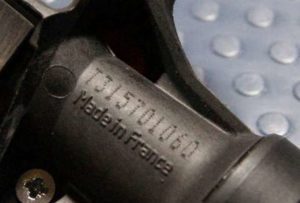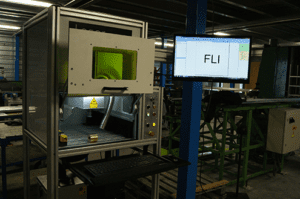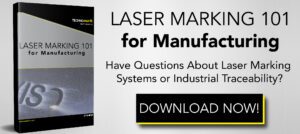6 Tips for Choosing the Best Laser Marking System for Your Business Needs

Laser marking systems provide reliability and long-term marking solutions for commercial and industrial applications, which resolves concerns about component tracking for many industries where the product is exposed to extreme heat or other conditions that cause wear and tear.
Choosing the best laser marking system for your production line means weighing the various factors that determine the most effective yet least time-consuming process to meet deadlines.
We compiled a list of six actionable tips to choose the most suitable laser marking system:
- Understand your marking needs
- Consider the type of laser technology
- Evaluate system performance and speed
- Assess software compatibility and ease of use
- Consider maintenance and durability
- Compare costs and return on investment
1. Understand Your Marking Needs
The use of laser marking systems is not the only choice to be made. Within the laser marking industry, various methods have been proven effective for product marking. The process to use depends on a variety of factors. Three marking methods that utilize lasers include:
- Engraving: With laser engraving, marks are made on the surface of an object with high heat that vaporizes the material into dust. This is done quickly and with precision, allowing for unmatched durability and readability, along with better turnaround times on orders that involve a large number of parts.
- Annealing: This process changes the color of the metal but does not remove any materials. This is because oxygen is diffused beneath the surface of the metal during a slow heating process. This process is only useful for metals like steel, stainless steel, and titanium.
- Etching: In this process, heated surfaces are allowed to expand, creating permanent marks in a faster and more efficient manner. This process provides a contrast that remains readable after post-treatments.
Different marking applications are ideal for different material types. For example, certain metals can be marked using the annealing process (as noted above). Meanwhile, etching or engraving can be useful for metals, plastics, and some other materials – such as wood. However, the process used makes a difference in the marking quality, depth, and the speed at which the marking process is completed.
2. Consider the Type of Laser Technology
Several types of lasers are used in laser marking systems:
Fiber lasers use a shorter wavelength than the CO2 laser and are capable of marking non-metallic surfaces. This process is commonly used for plastics and metal, as well as rubber.
CO2 lasers can be used to mark wood, plastic, cardboard, as well as metal. This type of laser uses CO2 gas to create an infrared laser beam. This beam cuts the mark into the material.
UV lasers have an adjustable wavelength and can be used on sensitive materials. This process is also possible to complete cold marking – which protects the product from heat degradation but still provides a readable, long-lasting mark.
3. Evaluate System Performance and Speed
Both marking speed and system performance impact overall productivity. Marking speed can lead to a faster completion rate for a larger order, as noted previously. Meanwhile, system performance can mean consistent production rates over time versus a more chaotic rate of production due to maintenance-related downtime.
4. Assess Software Compatibility and Ease of Use
Laser software is commonly hard to understand and to use because of the settings (except for an expert). User-friendly software offers adjustments that can be completed quickly and with minimal clicks. A secure connection via WiFi means the laser marking system can be utilized anywhere the WiFi reaches across the facility – or outside if necessary.
This allows for marking in real-time and allows for maintenance to be adjusted through the software as well.
5. Consider Maintenance and Durability
While reliable systems might come with a higher initial cost, they often lead to significant savings over time. Reduced downtime, fewer repairs, and longer intervals between major maintenance can drastically lower the total cost of ownership. Also, there are no consumables for laser marking (which is a durability and environment advantage).
Reliability also ties into safety. Systems that are less prone to malfunction reduce the risk of accidents in the workplace, protecting both your employees and your equipment.
Systems designed with ease of maintenance in mind often have modular components that can be easily replaced or serviced. Easy maintenance also means that you can potentially handle many issues in-house without needing to call in expensive external service technicians every time something needs tweaking.
6. Compare Costs and Return on Investment (ROI)
Choosing the right industrial laser marking system is a significant decision that can affect your operation’s efficiency, safety, and bottom line.
When evaluating options, consider not just the purchase price but also the costs associated with maintenance, repairs, and potential downtime. A more expensive system might be more cost-effective in the long run if it’s more reliable and easier to maintain.
These can then be weighed against the potential for increased ROI, which can make the final decision easier to reach. Calculating ROI for laser marking machines takes all of the following into consideration:
- Improved efficiency
- Productivity rates
- Product quality
Laser Marking Systems: Opting for Efficiency
Technology evolves, and so do the needs of your business. A system that is easy to maintain is generally more adaptable to upgrades and changes. This adaptability ensures that your investment remains valuable and relevant, even as new technologies emerge.
A reliable system delivers consistent quality in markings, which is critical for traceability, brand identity, and meeting industry standards. This consistency helps in maintaining product quality throughout the production cycle, reducing the risk of errors or defects. Finding that system means evaluating the above points and determining the most efficient system for your unique production needs.
Still looking for more information on industrial laser markers?





